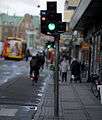Cycle track
A cycle track, separated bike lane[1] or protected bike lane (sometimes historically[2] referred to as a sidepath), is an exclusive bikeway that has elements of a separated path and on-road bike lane. A cycle track is located within or next to the roadway, but is made distinct from both the sidewalk and general purpose roadway by vertical barriers or elevation differences.[3][4]
In urban planning, cycle tracks are designed to encourage bicycling in an effort to relieve automobile congestion and reduce pollution, reduce bicycling fatalities and injuries by eliminating the need for cars and bicycles to jockey for the same road space, and to reduce overall confusion and tension for all users of the road. In the United States, an academic analysis of eight cycle tracks found that they had increased bike traffic on the street by 75 percent within one year of installation.[5] Rider surveys indicated that 10 percent of riders after installation would have chosen a different mode for that trip without the cycle track, and 25 percent said they were biking more in general since the installation of the cycle track.[6]
Cycle tracks may be one-way or two-way, and may be at road level, at sidewalk level, or at an intermediate level. They all have in common some separation from motor traffic with bollards, car parking, barriers or boulevards.[3] Barriers may include curbs, concrete berms, posts, planting/median strips, walls, trenches, or fences. They are often accompanied by a curb extension or other features at intersections to simplify crossing.
In the UK, cycle track is a roadway constructed specifically for use by cyclists, but not by any other vehicles. In Ireland cycle track also covers cycle lanes marked on the carriageway but only if accompanied by a specific sign. In the UK, a cycle track may be alongside a roadway (or carriageway) for all vehicles or it may be on its own alignment. The term does not include cycle lanes or other facilities within an all-vehicle carriageway.[7]
Gallery
.jpg) A two-way separated bike lane in Washington, D.C. with parked cars acting as a barrier between bicyclists and traffic
A two-way separated bike lane in Washington, D.C. with parked cars acting as a barrier between bicyclists and traffic Cycle tracks with concrete barriers in downtown Ottawa, Ontario, Canada on Laurier Avenue in 2011.
Cycle tracks with concrete barriers in downtown Ottawa, Ontario, Canada on Laurier Avenue in 2011. Separate traffic light for automobiles and bicycles on cycle track in Denmark
Separate traffic light for automobiles and bicycles on cycle track in Denmark Cycle track with green lanes through intersection in Ottawa, Ontario, Canada (also on Laurier) in 2011.
Cycle track with green lanes through intersection in Ottawa, Ontario, Canada (also on Laurier) in 2011.
See also
- Bikeway safety, including studies on the safety of cycle tracks
- Bikeway and legislation
- Bikeway controversies
- Bikeways
- Cycling infrastructure
- List of cycleways
- Outline of cycling
- Rail trail
References
- "Separated Bike Lane Planning and Design Guide - Publications - Bicycle and Pedestrian Program - Environment - FHWA".
- "Historian uncovers the forgotten U.S. protected bike lane boom of 1905". 2014-02-18.
- "Cycle Tracks - National Association of City Transportation Officials". 2011-12-14.
- "The Green Lane Project's style guide". Archived from the original on 2015-10-25. Retrieved 2015-11-03.
- "Lessons from the Green Lanes: Evaluating Protected Bike Lanes in the U.S. - Transportation Research and Education Center".
- "Separated Bike Lane Planning and Design Guide - Separated Bike Lane Planning and Design Guide - Publications - Bicycle and Pedestrian Program - Environment - FHWA".
- "Department for Transport - GOV.UK".